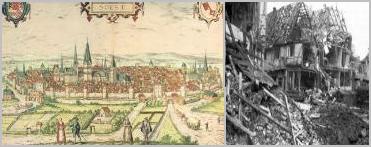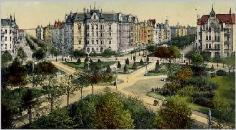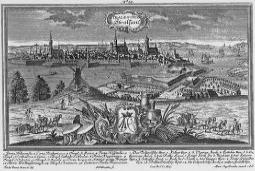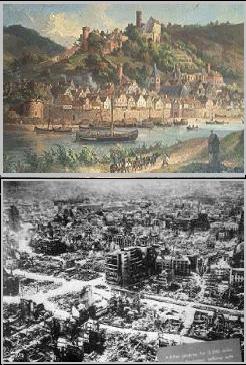
There is nothing much left of Siegen’s historic past. It was 80%, or almost totally destroyed from the 3,770 tons of Allied bombs dumped on it during the Second World War.

In the Second World War, Soest was the goal of 30 Allied bomb attacks because of nearby train yards and a factory in town. A third of the city was completely destroyed, especially the old churches. 60% of the houses were damaged or destroyed. The ancient Patrokli cathedral, built between 954 and 1166, whose tower was once called the “tower of Westphalia” because it stood nearly 100 meters high, was bombed in a 1945 Good Friday attack and all but totally destroyed.

In the year of 1600, Solingen consisted of 188 houses with about 1200 inhabitants and it was already famous for its sword-blades. The Thirty Years’ War put an end to Solingen’s prominence and it was 100 years before it fully recovered. The old castle was put back into temporary use as a fortress for a while during the Thirty Years’ War and not conquered by the invading Swedes. Afterwards, it was basically levelled. In the latter part of the 17th century, a group of disgruntled Lutheran swordsmiths from Solingen broke their guild oaths and took their sword-making skills and formulas with them to Shotley Bridge, then a remote village in England, where they set up shop. Shotley had rich iron deposits in the area and, because of the fast flowing waters of the River Derwent, was ideal for tempering swords. The little English town therefore became the heart of Britain’s swordmaking industry. Solingen passed to Prussia in 1815.
BierstadtOn November 4, 1944, 174 both American and British bombers dumped 4,921 tons of high explosives bombs and mines and 138 tons of incendiary bombs on it, igniting 900 fires. Although it destroyed the hospital and broke the water, electric and telephone lines, no historical buildings were yet hit. The second attack took place, the following day when there was no capacity to fight fires or save the town. In a 26 minute raid, 165 British bombers dropped 783 tons of high explosives bombs and 150 tons of incendiary bombs on Solingen, this time destroying the densely populated, ancient town center. 1,200 fires raged and the town was in rubble. 1,609 homes were totally destroyed, and 20,000 persons became shelterless. On November 5th, the English broadcast stated: “It is announced that Solingen, which is the heart of the German steel goods industry, is a dead city.” Also dead were 1,040 civilians.

Straubingers heard their first alarm in 1941. Starting from 1943, it sounded almost daily. The first heavy air raid came on November 4, 1944 at noon, hitting the train station and railway tracks. More heavy attacks took place on December 20 and February 5, 1945. The worst day in Straubing history is considered April 18, 1945 at the tail-end of the war. The bombing lasted 42 seconds, with 480.8 tons of high explosive bombs and 33.8 tons of incendiary bombs dropped to make it easy for the Americans who were poised to take the city. The town took 2 days to fight the fires and save people buried in cellars.
Over 300 people perished, with many more later succumbing to injuries sustained from the attack. In 1952, the last broken down cellar was dug out, and 30 more bodies were found. There were at least 500 civilian fatalities as a result of the bombings. A quarter of all houses and buildings in the old part of town were completely destroyed or severely damaged. The town was in ninth place in degree of destruction in Bavaria, with Munich at eighth place.

The construction of a canal to Berlin in 1914 enriched Stettin as a port with extensive installations. During World War II, Stettin suffered heavy damage from repeated bombings. On the night of April 20, 1943, following six previous attacks, Stettin was bombed with an area of a 100 acres devastated and 40,000 people left homeless. Massive combined Allied forces bombed it again in 1945 in a more murderous assault in the heart of the city, killing and injuring thousands. Although 80% of Stettin, including the old section, is on the left or western bank of the Oder, and the Potsdam agreement of 1945 only transferred Pomerania “east of the Oder” to Poland, this was later “reinterpreted” to include old German Stettin.
The predominantly German population was expelled and replaced by Poles who were trucked in to the city. About 500,000 humans died or remained missing when Eastern Pomerania and Stettin were subordinated in 1945 under Polish communist administration. Western Pomerania (without Stettin) was combined with Mecklenburg and fell under communist East German rule.

In WW Two, although Stralsund had alarms and minor bombings, they were not too worried since they had no military targets. This meant they had no real defenses either. On October 6, 1944, the US 381st bomber Group had orders to attack targets near Stettin to assist the Red Army, but because of bad weather, the 110 airplanes turned around and directed their machines at their secondary target, the old Hanseatic sea side city itself.
First they hit the power station and the water supply. Next, they hit the port area. Then they honed in on the unsuspecting city center and the residential area.A second attack wave arrived at 1:00 o’clock, and again hit the city center and the suburbs. The third wave was directed at civilian targets as well. The bombers dropped 1,500 high explosive and incendiary bombs with individual weights between 100 and 1,000 kilograms, altogether 247.5 tons. The first victims were workers at a sugar factory, whose shelter received a direct hit with the first attack wave.
In total, between 785 and 1,000 civilians were killed. 8,000 dwellings were gone, leaving 12,000 and 14,000 homeless. 385 of the 2,285 buildings of the medieval city center, 133 businesses, and the marketplace were gone as well. The centuries old Johanniskirche, the cloisters, the ancient gates, the old palace and the antique shipping houses were obliterated. The high explosives bombs had destroyed the roads and the incendiary bombs set the city aflame. Fire fighters could not use the public water to put out the fires, and rescue workers couldn’t reach the people because of the rubble. 16 fishing ships were sunken as well. On October 12th and 16th, 1944, mass funerals were held. Then it was turned over to the communists. The town is now again part of Germany.

Swabia was the birthplace of Kepler and Schiller, and home to hundreds of priceless architectural gems such as the old castle of the Dukes of Württemberg and the Stiftskirche, a Gothic cathedral from 1495 and It was also the burial place of nobles.
Mergenthaler Duke Eberhard GötzStuttgart is another city totally flattened by continuous Allied bombing, the worst raid taking place April 22, 1945. Stuttgart was bombed 53 times by the Allies, killing thousands of people. Although an important industrial and rail center, most targets were non-military, and purely cultural sites earmaked beforehand for destruction. Bombing attacks leveled 60% of Stuttgart’s buildings and left 52.972 million cubic feet of rubble. None of its landmarks or historic structures survived intact. The lovely city was now nothing but rubble and death. Under initial French occupation, there was a violent spree of violence against German women and girls, with almost 2,000 rapes reported.
The quaint town, with its Hansa style houses, grew up with fishing and the shipping industry, and its fortified entrance to the harbor was protected by two long breakwaters with the lighthouse on tiny Wolin Island protecting sailors of old. In 1897, the Kaiserfahrt canal was opened, with the waterway deepened between the Stettin harbor and the Baltic, and Swinemünde no longer had much strategic importance. Instead, it became a resort.
The Ruination of Swinemünde